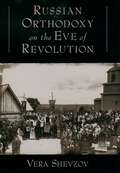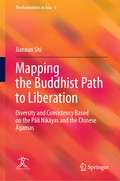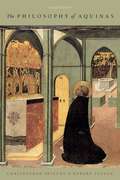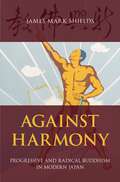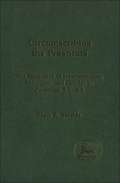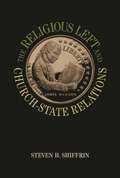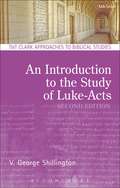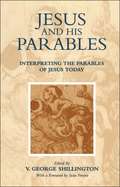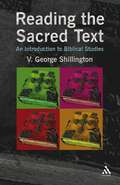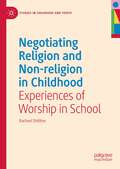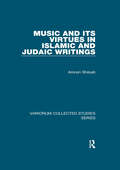- Table View
- List View
Mirror of Nature, Mirror of Self: Models of Consciousness in S=a.mkhya, Yoga, and Advaita Ved=anta (Rocher Indology)
by Dimitry ShevchenkoIn Indian philosophical traditions, a reflection in a mirror frequently serves as a metaphor, suggesting that just as a face in a mirror appears where it is not, so does consciousness. Mirror of Nature, Mirror of Self utilizes this metaphor to address metaphysical, epistemological, and theological problems within non-reductionist approaches to consciousness. Author Dimitry Shevchenko contends that consciousness and its properties--such as the sense of self, subjectivity, and experience of qualia--stand in falsely perceived relations to cognitive and perceptive processes. This book explores models of interaction between consciousness, the mind-body complex, and the world in the philosophical schools of S=a.mkhya, Yoga, and Advaita-Vedant. In a dialogue with psychoanalytical theory and analytic philosophy of mind, Shevchenko defends a new model of consciousness, integrating consciousness-mind dualism, mind naturalism, and representationalism about consciousness. Despite the overwhelming presence of pratibimbavadas, or "theories of reflection", in major philosophical traditions in India, they have received little scholarly attention. Mirror of Nature, Mirror of Self is the first systematic exploration of mirror models of consciousness across traditions. By grounding these theories in their historical intellectual context, Shevchenko contributes to an intense philosophical conversation between Indian reductionists and non-reductionists about consciousness. The book explores the impact of Indian mirror models on theories of mental representation, theories of knowledge, philosophy of language, debates on illusory causality and the relationship between noumena and phenomena, as well as soteriological and theological theories. Finally, by comparing mirror models of consciousness in Indian philosophy with Jacques Lacan's theory of the mirror stage and by engaging with theories of consciousness in analytic philosophy, this study contributes to contemporary debates across philosophical disciplines. This is an open access title. It is available to read and download as a free PDF version on the Oxford Academic platform. It has been made available under a Creative Commons Attribution-Non Commercial-No Derivatives 4.0 International licence.
Piety and Responsibility: Patterns of Unity in Karl Rahner, Karl Barth, and Vedanta Desika (Routledge New Critical Thinking in Religion, Theology and Biblical Studies)
by John N. ShevelandThis book analyzes the writings of Karl Rahner, Karl Barth, and Vedanta Desika to disclose how each construes "piety" and "responsibility" as integral to each other. Each theologian expresses a fundamental unity of love of God and love of neighbour. Sheveland explores this unity in ecumenical and interreligious frameworks, showing how these authors privilege theology as practice, enactment, or simply as ethical. He uses the Renaissance genre of musical polyphony as a methodological tool by which to explore the aesthetic quality and the similarity-in-difference of the theological voices being compared. Polyphony's application to comparative theology includes the avoidance of caricature, domestication, and antagonism. In place of these is offered a fundamentally aesthetic paradigm by which to hear theological voices in terms of their unity-in-distinction.
Piety and Responsibility: Patterns of Unity in Karl Rahner, Karl Barth, and Vedanta Desika (Routledge New Critical Thinking in Religion, Theology and Biblical Studies)
by John N. ShevelandThis book analyzes the writings of Karl Rahner, Karl Barth, and Vedanta Desika to disclose how each construes "piety" and "responsibility" as integral to each other. Each theologian expresses a fundamental unity of love of God and love of neighbour. Sheveland explores this unity in ecumenical and interreligious frameworks, showing how these authors privilege theology as practice, enactment, or simply as ethical. He uses the Renaissance genre of musical polyphony as a methodological tool by which to explore the aesthetic quality and the similarity-in-difference of the theological voices being compared. Polyphony's application to comparative theology includes the avoidance of caricature, domestication, and antagonism. In place of these is offered a fundamentally aesthetic paradigm by which to hear theological voices in terms of their unity-in-distinction.
Russian Orthodoxy on the Eve of Revolution
by Vera ShevzovSince the collapse of the Soviet Union, Orthodox Christianity in Russia has enjoyed a remarkable resurgence. Many Russians are now looking to the history of their faith as they try to rebuild a lost way of life. Vera Shevzov has spent ten years researching Orthodoxy as it was lived in the years before the 1917 Revolution. In Russian Orthodoxy on the Eve of Revolution, she draws on a rich variety of previously untapped archival sources and published works unavailable in the West to reconstruct the religious world of lay people. Shevzov traces the means by which men and women shaped their religious lives in an ecclesiastical system that was often dominated by bureaucrats and monastic bishops. She finds vivid displays of resistance to the official system and equally vivid affirmations of faith. Focusing on various "centers" of religious life--the church temple, chapels, feasts, icons, and the Virgin Mary--she traces the rituals, beliefs, and communal dynamics that lent these centers meaning. Shevzov also presents the conflicting voices of ecclesiastical officials. She questions the notion that the only challenge to Orthodoxy at the end of the ancien regime came from outsiders such as Marxist revolutionaries, atheistic intellectuals, and urban factor workers. Instead, she shows that a different but equally great challenge emerged within the faith community itself. Indeed, the late nineteenth and early twentieth century is revealed as one of the most dynamic periods in the history of Russian Orthodoxy, characterized by debates analogous to the Reformation or the era of Vatican II. Russian Orthodoxy on the Eve of Revolution breaks new ground by giving voice to the previously-ignored common people during this period immediately preceding one of the most important events of the twentieth century.
Russian Orthodoxy on the Eve of Revolution
by Vera ShevzovSince the collapse of the Soviet Union, Orthodox Christianity in Russia has enjoyed a remarkable resurgence. Many Russians are now looking to the history of their faith as they try to rebuild a lost way of life. Vera Shevzov has spent ten years researching Orthodoxy as it was lived in the years before the 1917 Revolution. In Russian Orthodoxy on the Eve of Revolution, she draws on a rich variety of previously untapped archival sources and published works unavailable in the West to reconstruct the religious world of lay people. Shevzov traces the means by which men and women shaped their religious lives in an ecclesiastical system that was often dominated by bureaucrats and monastic bishops. She finds vivid displays of resistance to the official system and equally vivid affirmations of faith. Focusing on various "centers" of religious life--the church temple, chapels, feasts, icons, and the Virgin Mary--she traces the rituals, beliefs, and communal dynamics that lent these centers meaning. Shevzov also presents the conflicting voices of ecclesiastical officials. She questions the notion that the only challenge to Orthodoxy at the end of the ancien regime came from outsiders such as Marxist revolutionaries, atheistic intellectuals, and urban factor workers. Instead, she shows that a different but equally great challenge emerged within the faith community itself. Indeed, the late nineteenth and early twentieth century is revealed as one of the most dynamic periods in the history of Russian Orthodoxy, characterized by debates analogous to the Reformation or the era of Vatican II. Russian Orthodoxy on the Eve of Revolution breaks new ground by giving voice to the previously-ignored common people during this period immediately preceding one of the most important events of the twentieth century.
Mapping the Buddhist Path to Liberation: Diversity and Consistency Based on the Pāli Nikāyas and the Chinese Āgamas (The Humanities in Asia #9)
by Jianxun ShiDue to the diversity in Buddhism, its essence remains a puzzle. This book investigates the Buddhist path to liberation from a practical and critical perspective by searching for patterns found in the Pāli Nikāyas and the Chinese Āgamas. The early discourses depict the Buddhist path as a network of routes leading to the same goal: liberation from suffering. This book summarizes various teachings in three aspects, provides a template theory for systematically presenting the formulas of the sequential training of the path, and analyses the differences and similarities among diverse descriptions of the path in the early Buddhist texts. By offering a comprehensive map of the Buddhist path, this book will appeal to scholars and students of Buddhist studies as well as those practitioners with a serious interest in the Buddhist path.
Detained without Cause: Muslims' Stories of Detention and Deportation in America after 9/11 (Palgrave Studies in Oral History)
by I. ShiekhImmigrants from Pakistan, Egypt, India, and Palestine who were racially profiled and detained following the September 11 attacks tell their personal stories in a collection which explores themes of transnationalism, racialization, and the global war on terror, and explains the human cost of suspending civil liberties after a wartime emergency.
The Philosophy of Aquinas
by Christopher Shields Robert PasnauThis new and updated edition of Christopher Shields and Robert Pasnau's The Philosophy of Aquinas introduces the Aquinas' overarching explanatory framework in order to provide the necessary background to his philosophical investigations across a wide range of areas: rational theology, metaphysics, philosophy of human nature, philosophy of mind, and ethical and political theory. Although not intended to provide a comprehensive evaluation of all aspects of Aquinas' far-reaching writings, the volume presents a systematic introduction to the principal areas of his philosophy and attends no less to Aquinas' methods and argumentative strategies than to his ultimate conclusions. The authors have updated the second edition in light of recent scholarship on Aquinas, while streamlining and refining their presentation of the key elements of Aquinas' philosophy.
Against Harmony: Progressive and Radical Buddhism in Modern Japan
by James Mark ShieldsAgainst Harmony traces the history of progressive and radical experiments in Japanese Buddhist thought and practice, from the mid-Meiji period through the early Showa. Perhaps the two best representations of progressive Buddhism during this time were the New Buddhist Fellowship (1899-1915) and the Youth League for Revitalizing Buddhism (1931-1936), both non-sectarian, lay movements well-versed in both classical Buddhist texts and Western philosophy and religion. Their work effectively collapsed commonly held distinctions between religion, philosophy, ethics, politics, and economics. Unlike many others of their day, they did not regard the novel forces of modernization as problematic and disruptive, but as opportunities. James Mark Shields examines the intellectual genealogy and alternative visions of progressive and radical Buddhism in the decades leading up to the Pacific War. Exposing the variety in the conceptions and manifestations of progress, reform, and modernity in this period, he outlines their important implications for postwar and contemporary Buddhism in Japan and elsewhere.
Against Harmony: Progressive and Radical Buddhism in Modern Japan
by James Mark ShieldsAgainst Harmony traces the history of progressive and radical experiments in Japanese Buddhist thought and practice, from the mid-Meiji period through the early Showa. Perhaps the two best representations of progressive Buddhism during this time were the New Buddhist Fellowship (1899-1915) and the Youth League for Revitalizing Buddhism (1931-1936), both non-sectarian, lay movements well-versed in both classical Buddhist texts and Western philosophy and religion. Their work effectively collapsed commonly held distinctions between religion, philosophy, ethics, politics, and economics. Unlike many others of their day, they did not regard the novel forces of modernization as problematic and disruptive, but as opportunities. James Mark Shields examines the intellectual genealogy and alternative visions of progressive and radical Buddhism in the decades leading up to the Pacific War. Exposing the variety in the conceptions and manifestations of progress, reform, and modernity in this period, he outlines their important implications for postwar and contemporary Buddhism in Japan and elsewhere.
Critical Buddhism: Engaging with Modern Japanese Buddhist Thought
by James Mark ShieldsIn the late 1980s and early 1990s, the relative calm world of Japanese Buddhist scholarship was thrown into chaos with the publication of several works by Buddhist scholars Hakamaya Noriaki and Matsumoto Shiro, dedicated to the promotion of something they called Critical Buddhism (hihan bukkyo). In their quest to re-establish a "true" - rational, ethical and humanist - form of East Asian Buddhism, the Critical Buddhists undertook a radical deconstruction of historical and contemporary East Asian Buddhism, particularly Zen. While their controversial work has received some attention in English-language scholarship, this is the first book-length treatment of Critical Buddhism as both a philosophical and religious movement, where the lines between scholarship and practice blur. Providing a critical and constructive analysis of Critical Buddhism, particularly the epistemological categories of critica and topica, this book examines contemporary theories of knowledge and ethics in order to situate Critical Buddhism within modern Japanese and Buddhist thought as well as in relation to current trends in contemporary Western thought.
Critical Buddhism: Engaging with Modern Japanese Buddhist Thought
by James Mark ShieldsIn the late 1980s and early 1990s, the relative calm world of Japanese Buddhist scholarship was thrown into chaos with the publication of several works by Buddhist scholars Hakamaya Noriaki and Matsumoto Shiro, dedicated to the promotion of something they called Critical Buddhism (hihan bukkyo). In their quest to re-establish a "true" - rational, ethical and humanist - form of East Asian Buddhism, the Critical Buddhists undertook a radical deconstruction of historical and contemporary East Asian Buddhism, particularly Zen. While their controversial work has received some attention in English-language scholarship, this is the first book-length treatment of Critical Buddhism as both a philosophical and religious movement, where the lines between scholarship and practice blur. Providing a critical and constructive analysis of Critical Buddhism, particularly the epistemological categories of critica and topica, this book examines contemporary theories of knowledge and ethics in order to situate Critical Buddhism within modern Japanese and Buddhist thought as well as in relation to current trends in contemporary Western thought.
The Democratic Virtues of the Christian Right
by Jon A. ShieldsThe Christian Right is frequently accused of threatening democratic values. But in The Democratic Virtues of the Christian Right, Jon Shields argues that religious conservatives have in fact dramatically increased and improved democratic participation and that they are far more civil and reasonable than is commonly believed. Shields interviewed leaders of more than thirty Christian Right organizations, observed movement activists in six American cities, and analyzed a wide variety of survey data and movement media. His conclusions are surprising: the Christian Right has reinvigorated American politics and fulfilled New Left ideals by mobilizing a previously alienated group and by refocusing politics on the contentious ideological and moral questions that motivate citizens. Shields also finds that, largely for pragmatic reasons, the vast majority of Christian Right leaders encourage their followers to embrace deliberative norms in the public square, including civility and secular reasoning. At the same time, Shields highlights a tension between participatory and deliberative ideals since Christian Right leaders also nurture moral passions, prejudices, and dogmas to propel their movement. Nonetheless, the Christian Right's other democratic virtues help contain civic extremism, sharpen the thinking of activists, and raise the level and tenor of political debate for all Americans.
The Democratic Virtues of the Christian Right
by Jon A. ShieldsThe Christian Right is frequently accused of threatening democratic values. But in The Democratic Virtues of the Christian Right, Jon Shields argues that religious conservatives have in fact dramatically increased and improved democratic participation and that they are far more civil and reasonable than is commonly believed. Shields interviewed leaders of more than thirty Christian Right organizations, observed movement activists in six American cities, and analyzed a wide variety of survey data and movement media. His conclusions are surprising: the Christian Right has reinvigorated American politics and fulfilled New Left ideals by mobilizing a previously alienated group and by refocusing politics on the contentious ideological and moral questions that motivate citizens. Shields also finds that, largely for pragmatic reasons, the vast majority of Christian Right leaders encourage their followers to embrace deliberative norms in the public square, including civility and secular reasoning. At the same time, Shields highlights a tension between participatory and deliberative ideals since Christian Right leaders also nurture moral passions, prejudices, and dogmas to propel their movement. Nonetheless, the Christian Right's other democratic virtues help contain civic extremism, sharpen the thinking of activists, and raise the level and tenor of political debate for all Americans.
Circumscribing the Prostitute: The Rhetorics Of Intertexuality, Metaphor, And Gender In Jeremiah 3. 1-4. 4 (The Library of Hebrew Bible/Old Testament Studies)
by Mary E. ShieldsIn Jeremiah 3.1-4.4 the prophet employs the image of Israel as God's unfaithful wife, who acts like a prostitute. The entire passage is a rich and complex rhetorical tapestry designed to convince the people of Israel of the error of their political and religious ways, and their need to change before it is too late. As well as metaphor and gender, another important thread in the tapestry is intertextuality, according to which the historical, political and social contexts of both author and reader enter into dialogue and thus produce different interpretations. But, as Shields shows in her final chapter, it is in the end the rhetoric of gender that actually constructs the text, providing the frame, the warp and woof, of the entire tapestry, and thus the prophet's primary means of persuasion.
The Religious Left and Church-State Relations
by Steven H. ShiffrinIn The Religious Left and Church-State Relations, noted constitutional law scholar Steven Shiffrin argues that the religious left, not the secular left, is best equipped to lead the battle against the religious right on questions of church and state in America today. Explaining that the chosen rhetoric of secular liberals is poorly equipped to argue against religious conservatives, Shiffrin shows that all progressives, religious and secular, must appeal to broader values promoting religious liberty. He demonstrates that the separation of church and state serves to protect religions from political manipulation while tight connections between church and state compromise the integrity of religious institutions. Shiffrin discusses the pluralistic foundations of the religion clauses in the First Amendment and asserts that the clauses cannot be confined to the protection of liberty, equality, or equal liberty. He explores the constitutional framework of religious liberalism, applying it to controversial examples, including the Pledge of Allegiance, the government's use of religious symbols, the teaching of evolution in public schools, and school vouchers. Shiffrin examines how the approaches of secular liberalism toward church-state relations have been misguided philosophically and politically, and he illustrates why theological arguments hold an important democratic position--not in courtrooms or halls of government, but in the public dialogue. The book contends that the great issue of American religious politics is not whether religions should be supported at all, but how religions can best be strengthened and preserved.
The Religious Left and Church-State Relations
by Steven H. ShiffrinIn The Religious Left and Church-State Relations, noted constitutional law scholar Steven Shiffrin argues that the religious left, not the secular left, is best equipped to lead the battle against the religious right on questions of church and state in America today. Explaining that the chosen rhetoric of secular liberals is poorly equipped to argue against religious conservatives, Shiffrin shows that all progressives, religious and secular, must appeal to broader values promoting religious liberty. He demonstrates that the separation of church and state serves to protect religions from political manipulation while tight connections between church and state compromise the integrity of religious institutions. Shiffrin discusses the pluralistic foundations of the religion clauses in the First Amendment and asserts that the clauses cannot be confined to the protection of liberty, equality, or equal liberty. He explores the constitutional framework of religious liberalism, applying it to controversial examples, including the Pledge of Allegiance, the government's use of religious symbols, the teaching of evolution in public schools, and school vouchers. Shiffrin examines how the approaches of secular liberalism toward church-state relations have been misguided philosophically and politically, and he illustrates why theological arguments hold an important democratic position--not in courtrooms or halls of government, but in the public dialogue. The book contends that the great issue of American religious politics is not whether religions should be supported at all, but how religions can best be strengthened and preserved.
An Introduction to the Study of Luke-Acts (T&T Clark Approaches to Biblical Studies)
by V. George ShillingtonV. George Shillington introduces readers to the text, texture and context of Luke-Acts in this tried and tested introduction, now in its second edition. Using various approaches currently practiced by biblical scholars Shillington outlines the methods of biblical interpretation and then shows how they might be applied to the texts in question.Through historical criticism Shillington looks at and explains questions of authorship, the time and setting of the composition, sources and historical background. Taking a social-science approach he examines the society and culture of the time. Literary readings include narrative, socio-rhetorical, and audience-response approaches, while a theological reading asks how the literary texture and themes of Luke-Acts shape the convictions of Christian communities, past and present. Incorporating modern approaches in the field, Shillington looks at postcolonial and feminist criticism and how they have changed our understanding of these books. Each chapter concludes with a list of further relevant resources, and pertinent review questions. The text is accompanied by charts and diagrams to illustrate key points of language and structure.
An Introduction to the Study of Luke-Acts (T&T Clark Approaches to Biblical Studies)
by V. George ShillingtonV. George Shillington introduces readers to the text, texture and context of Luke-Acts in this tried and tested introduction, now in its second edition. Using various approaches currently practiced by biblical scholars Shillington outlines the methods of biblical interpretation and then shows how they might be applied to the texts in question.Through historical criticism Shillington looks at and explains questions of authorship, the time and setting of the composition, sources and historical background. Taking a social-science approach he examines the society and culture of the time. Literary readings include narrative, socio-rhetorical, and audience-response approaches, while a theological reading asks how the literary texture and themes of Luke-Acts shape the convictions of Christian communities, past and present. Incorporating modern approaches in the field, Shillington looks at postcolonial and feminist criticism and how they have changed our understanding of these books. Each chapter concludes with a list of further relevant resources, and pertinent review questions. The text is accompanied by charts and diagrams to illustrate key points of language and structure.
Jesus and his Parables: Interpreting the Parables of Jesus Today
by V. George ShillingtonA complete range of modern approaches to interpreting the parables. Not only a textbook, but readable and accessible and as engaging to the general reader as to the scholar and minister.
Reading the Sacred Text: An Introduction in Biblical Studies
by V. George ShillingtonA comprehensive manual for anyone wishing to become competent in reading and understanding the Scriptures of the Judeo-Christian tradition.The chapters of this book introduce the reader to all aspects of biblical studies. They guide the reader through the maze, from 'Venturing In' to 'Negotiated Reading'. There are sections on, for example, considering the self-consciousness of the reader/interpreter, the interaction of the tradition with the text of Scripture through the ages, the various literary genres together with the principal forms within the larger biblical documents, ways of reading the text in the modern and post-modern periods, how the academic reading of Scripture and the church reading interact, the relation between competent reading of the sacred text and the preparation and delivery of the sermon, the place of dialogue in the interpretive process.The conclusion sums up the discussion throughout the book and focuses the issues for a competent reading of the Bible and related writings.Student-friendly features include, at the end of each chapter:--An Objective, summarizing the content and objective of the chapter12-14 lead questions with act as in-depth study exercises--Full bibliography and suggestions for further reading
Negotiating Religion and Non-religion in Childhood: Experiences of Worship in School (Studies in Childhood and Youth)
by Rachael ShillitoeThis book explores how and if the mandate for children to worship in schools can be justified within the context of declining church attendance and increasing nonreligious identification in British society. Shillitoe asks what place compulsory worship has in an increasingly diverse and plural society, and what the answer means for the relationship between religion, the secular, and education more broadly. Through in-depth ethnographic fieldwork from across three schools in southwest England, the book reveals how examining the significance of children’s experiences expands our understanding of both collective worship in schooling and religion in social life more broadly and demonstrates that adult-centric anxieties and assumptions in this area do not always reflect the experiences of children.
Music and its Virtues in Islamic and Judaic Writings (Variorum Collected Studies)
by Amnon ShiloahA fascinating aspect of the study of music in medieval Islamic and Judaic writings is the broad and interdisciplinary nature of the works and treatises in which it is covered. In addition, such works verbalize an art that was transmitted orally and took shape spontaneously, typically with improvisation during performance. As a result of this outlook the musical concept (or science) is often intertwined with practice (or history). This second collection by Amnon Shiloah brings together twenty-two studies exemplifying such multi-faceted viewpoints on the world of sounds and its virtue. The first studies concern the origin and originators of music and to how its essential constituents came into being; included here is the art of dance along with the controversial attitudes towards it. Next comes the symbolic, philosophical and metaphorical interpretation of music; one of the major ideas epitomizing this approach claimed that the pursuit of knowledge is the path to human perfection and happiness. There follow studies on the transmission of knowledge, along with some annotated key works dealing with therapeutic effects. The last articles focus on cultural traditions elaborated on European soil developing a particular style and musical practice, centred on the Iberian Peninsula, which was the scene of one of the most fascinating examples of cultural interchange.
Music and its Virtues in Islamic and Judaic Writings (Variorum Collected Studies)
by Amnon ShiloahA fascinating aspect of the study of music in medieval Islamic and Judaic writings is the broad and interdisciplinary nature of the works and treatises in which it is covered. In addition, such works verbalize an art that was transmitted orally and took shape spontaneously, typically with improvisation during performance. As a result of this outlook the musical concept (or science) is often intertwined with practice (or history). This second collection by Amnon Shiloah brings together twenty-two studies exemplifying such multi-faceted viewpoints on the world of sounds and its virtue. The first studies concern the origin and originators of music and to how its essential constituents came into being; included here is the art of dance along with the controversial attitudes towards it. Next comes the symbolic, philosophical and metaphorical interpretation of music; one of the major ideas epitomizing this approach claimed that the pursuit of knowledge is the path to human perfection and happiness. There follow studies on the transmission of knowledge, along with some annotated key works dealing with therapeutic effects. The last articles focus on cultural traditions elaborated on European soil developing a particular style and musical practice, centred on the Iberian Peninsula, which was the scene of one of the most fascinating examples of cultural interchange.
Overseas Shinto Shrines: Religion, Secularity and the Japanese Empire (Bloomsbury Shinto Studies)
by Karli ShimizuThrough extensive use of primary resources and fieldwork, this detailed study examines overseas Shinto shrines and their complex role in the colonization and modernization of newly Japanese lands and subjects. Shinto shrines became one of the most visible symbols of Japanese imperialism in the early 20th century. From 1868 to 1945, shrines were constructed by both the government and Japanese migrants across the Asia-Pacific region, from Sakhalin to Taiwan, and from China to the Americas. Drawing on theories about the constructed nature of the modern categories of 'religion' and the 'secular', this book argues that modern Shinto shrines were largely conceived and treated as secular sites within a newly invented Japanese secularism, and that they played an important role in communicating changed conceptions of space, time and ethics in imperial subjects. Providing an example of the invention of a non-Western secularity, this book contributes to our understanding of the relationship between religion, secularism and the construction of the modern state.


